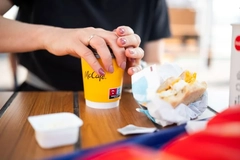
- Industry news
Industry news
- Category news
- Reports
- Key trends
- Multimedia
Multimedia
- Journal
- Events
- Suppliers
Suppliers
- Home
- Industry news
Industry news
- Category news
- Reports
- Key trends
- Multimedia
Multimedia
- Events
- Suppliers
Suppliers
Sherwood Technology has launched DataLase Edible, a revolutionary solution for laser marking edible products such as fresh produce and hard-shelled confectionery

The company claims that this new generation, patented additive allows a safe, high contrast image to be formed directly onto edible products. The process utilises a unique chemistry that reacts with a beam of low power laser light, changing colour, and thereby creating a positive image.
The company claims that this new generation, patented additive allows a safe, high contrast image to be formed directly onto edible products. The process utilises a unique chemistry that reacts with a beam of low power laser light, changing colour, and thereby creating a positive image. The concept also taps into the current drive towards enhancing traceability, with many sectors of the food industry increasingly turning towards 'on-product' marking. DataLase Edible allows an expanding range of edible products, for example eggs and fruit, to be marked using CO2 lasers. The additives, which come in the form of a dry powder or water-based solution, are applied to the surface of the food product via a spray system or by tumble coating and then marked by a low power CO2 laser. The coating undergoes a safe colour-change process, creating a high contrast, stable image that is produced from 100 per cent edible components. Due to the sensitivity of the coating to the laser light, only a fraction of the laser energy that would be required to etch or burn an image into the surface is used, preserving the integrity of the surface of the edible material being marked. Traditionally fresh produce, for example fruit and some vegetables are identified using pressure sensitive pre-printed labels. Digital, variable data such as 'product look up' codes, best before dates and country of origin are increasingly required, making pre-printing and holding stock of all the variations an unwieldy and costly process. These labels are also subject to a range of limitations, including a tendency for the labels to fall off the produce and leave an adhesive residue on the skin. In addition, it is feared that the labels harbour bacterial growth and may also cause a choking hazard to infants.











